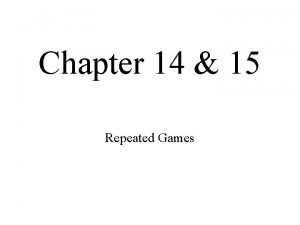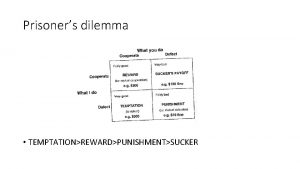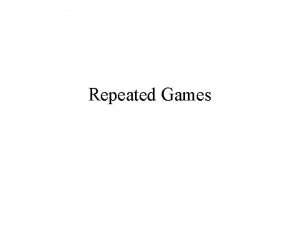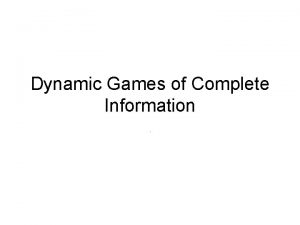8 The Prisoners Dilemma and repeated games In














- Slides: 14

8: The Prisoners’ Dilemma and repeated games In this section we shall learn How repeated play of a game opens up many new strategic possibilities How to improve the outcome you achieve from a game by making your current play contingent on how your opponent played in the past. How to make the other player be cooperative. Warning: Warning We shall also learn when repeated play gains us nothing. Games People Play.

Games People Play.

The Prisoners’ Dilemma Finite repetition. What happens when the game is repeated with the same opponent a finite number of times? Criminal #2 Confes Criminal s #1 Deny Games People Play. Confes s Deny 10, 10 1, 25 25, 1 3, 3

The Prisoners’ Dilemma Finite repetition. The last play of the game is a one-shot-game. So the equilibrium is {C, C}. Now in the last by on play the players know {C, C} will be played in the last stage. So play {C, C} in the last but one stage and so on. This is just backwards induction. But was it the outcome of actual play? Criminal #2 Criminal #1 Games People Play. Confess Deny Confess 10, 10 1, 25 Deny 25, 1 3, 3

Games People Play.

The Prisoners’ Dilemma Indeterminate number of repetitions. What happens when the number of repetitions and thus the end of the game is unknown? Criminal #2 Criminal Confess #1 Deny Games People Play. Confess Deny 10, 10 1, 25 25, 1 3, 3

The Prisoners’ Dilemma Indeterminate number of repetitions. The key element here is that the players can adopt contingent strategies. If you do this on this round of the game, then I will respond on the next round. This option remains available if there is some chance there will be a next round. Criminal #2 Criminal 1# Games People Play. Confess Deny Confess 10, 10 1, 25 Deny 25, 1 3, 3

The Prisoners’ Dilemma Trigger Strategy Equilibria. If someone “misbehaves” in one round of the game they can be punished in the next. This option remains available if there is some chance there will be a next round. If this threat is sufficient to change the players strategies then we have found a new equilibrium termed a trigger strategy equilibrium. The simplest form of trigger strategy is called tit-for-tat. Whatever you do in this round of the game I will do in the next round. Games People Play.

Yogi on Trigger Strategy Equilibria "You should always go to other people's funerals; otherwise, they won't come to yours. " – Yogi Berra. Games People Play.

The Prisoners’ Dilemma Trigger Strategy Equilibria – Tit-for-tat. Nixon #2 For sake of the example let the payoff matrix be C C D 10, 10 1, 15 Nixon #1 Let both Nixons be initially playing deny. D 15, 1 3, 3 #1 considers playing confess This gets him 1 today. But 10 next period when #2 plays tit-for-tat and also denies. Alternatively he can continue with deny. This gets him 3 today. Then 3 in the next period as #2 plays tit-for-tat and also plays deny. Since 6 < 11 he plays deny today and deny tomorrow, as does #2 who faces identical incentives. Games People Play.

The Prisoners’ Dilemma Trigger Strategy Equilibria. Tit-for-tat is not the only possible punishment. In some circumstances more of a threat is needed to ensure cooperation (check out our example with the original numbers). One possibility is the “Grim Punishment Strategy” which states if you cheat on our deal I will punish you forever. Since {C, C} is a Nash equilibrium in our game this is not ridiculous. More extreme still, but somewhat strange, is the “Severe Punishment Strategy” I do something worse to you than Nash. I do this not because if I do not you punish me for not punishing you and visa versa !! Games People Play.

The Prisoners’ Dilemma Infinitely Repeated Games and Discounting. It might seem that almost any outcome can be supported by a grim strategy since the punishment appears to be infinite. This isn’t the case because we are impatient, that is we discount the future. A dollar today is better than a dollar in a years time. Thus since punishments occur in the future and the rewards from non-cooperation occur today it may be difficult to enforce a good outcome. As an example consider discounting with a tit-for-tat trigger strategy. Games People Play.

The Prisoners’ Dilemma Nixon #2 Nixon #1 C D C 10, 10 1, 15 D 15, 1 3, 3 Nixon #1 considers playing confess This gets him 1 today. But d(10) next period when #2 plays tit-for-tat and also denies. Alternatively he can continue with deny. This gets him 3 today. Then d(3) in the next period as #2 plays tit-for-tat and also plays deny. The Strategy fails if (recall small number are better in this example). 3+d(3) > 1+d(10) or 2/7 > d And the same incentives apply to #2. Games People Play.

Yogi on Discounting "A nickel isn't worth a dime today. " – Yogi Berra. Games People Play.
 Prisoners dilemma
Prisoners dilemma Prisoners dilemma
Prisoners dilemma Nash equilibrium prisoners dilemma
Nash equilibrium prisoners dilemma Folk theorem
Folk theorem Infinitely repeated games
Infinitely repeated games Prisoners dillemma
Prisoners dillemma When prisoners come home
When prisoners come home After they arrived the prisoners are supposed to shower
After they arrived the prisoners are supposed to shower Action for prisoners families
Action for prisoners families Famous san quentin prisoners
Famous san quentin prisoners Outdoor games and indoor games
Outdoor games and indoor games Hunger games chapter 17 questions and answers
Hunger games chapter 17 questions and answers Repeated back and forth motion
Repeated back and forth motion Divine command theory and euthyphro dilemma
Divine command theory and euthyphro dilemma Repeated percentage change questions
Repeated percentage change questions

























